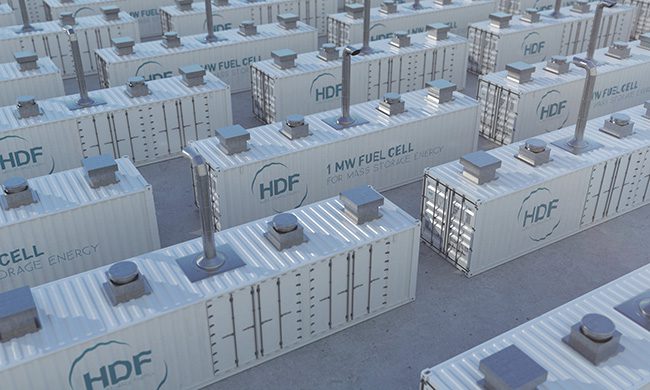Solar Power/Hydrogen Project Underway in DRC
Hydrogène de France (HDF Energy) has entered into a partnership with the government of Kinshasa, a city-province and capital of the Democratic Republic of Congo (DRC) in Africa, for construction and operation of a photovoltaic (PV) solar power plant that would be used to produce green hydrogen. Officials said it’s the first such solar/hydrogen project planned in Central Africa, following on a similar agreement reached in November 2022 to build a hydrogen plant powered by renewable energy in Namibia in southwestern Africa.
HDF Energy, an independent power producer, in January announced it had begun a feasibility study for the Kinshasa installation. Flavien Nkui Misuru, a commissioner-general in Kinshasa’s government, said regional authorities welcomed the project because it would support the area’s electricity supply and bring more economic opportunities with its hydrogen production. Misuru said the government would plan more similar projects should the HDF effort prove successful.
Kinshasa, like other provinces in the DRC, depends on hydroelectricity for most of its power supply—in its case 98%. That’s problematic as drought conditions impact the supply of water across Africa, including for the Congo River that borders Kinshasa. The DRC’s hydropower dams have combined generation capacity of 2,844 MW, according to government data. The National Investment Promotion Energy group, known as ANAPI (Agence nationale pour la promotion des investissements), estimates only about 44% of Kinshasa’s residents have access to electricity. Officials have said taking advantage of the region’s solar power potential will be critical to sustain economic growth.
The DRC government in 2020 moved forward with a 600-MW solar photovoltaic plant, called Kinshasa Solar City, in Menkao, a district located in the municipality of Maluku in Kinshasa. That project was led by Sun Plus, a subsidiary of The Sandi Group (TSG), a global provider of infrastructure improvement and modernization services. The solar farm feeds into the power grid operated by National Electricity Co. (Snel), the state-owned utility. The Solar City project was designed to incorporate other smaller PV solar installations, with eventual cumulative capacity of about 1,000 MW.
 |
|
1. HDF Energy is a global provider of large-scale hydrogen-to-power infrastructure, using renewable resources combined with the company’s fuel cell systems. Courtesy: HDF Energy |
HDF Energy is based in Bordeaux, France. The company develops and operates high-capacity, large-scale hydrogen-to-power infrastructure, to provide firm or on-demand electricity from renewable resources such as wind and solar (what it calls Renewstable plants), combined with high-power “MultiMegawatt” fuel cell systems (Figure 1). Officials said the solar/hydrogen power plant would be located in the southern part of Kinshasa.
Provincial authorities said they support HDF “to make effective progress in the development of this first hydrogen power plant.” Misuru, who heads Kinshasa’s division responsible for energy, livestock, and fisheries, said, “In a context where we need to rapidly reinforce the means of electricity production for the city-province, the power plant project by HDF, given its technical characteristics, is welcomed with great satisfaction. Through the measures we are putting in place under the memorandum of understanding, we are seeking to encourage the emergence, as soon as possible, of this first hydrogen power plant project, which can then be duplicated.”
The population of Kinshasa is estimated at more than 17 million, spread over a vast area. It is one of 26 provinces in the DRC, and the third-largest metropolitan area in Africa after Cairo, Egypt, and Lagos, Nigeria. Officials have said the region is prone to load-shedding to help balance the electricity supply with demand, a situation noted by Misuru in his comments about needing more power generation projects.
Nicolas Lecomte, HDF’s director for Southern and Eastern Africa, said his company’s new facility would help satisfy more of Kinshasa’s power demand. “Our solution, the Renewstable high-power hydrogen power plant, is particularly suitable not only to support the necessary electricity but also the network services to improve the stability and operating conditions of the electricity supply. In addition, our solution is an alternative of choice of supply isolated networks and contributing to the national development program of the 145 territories. It can be deployed in rural and remote areas. Also, the hydrogen component of our projects allows the country to acquire skills that will make it possible to better seize opportunities in the field.”
HDF has installed or is building its renewable, large-scale power plants in several countries. The group in November of last year formed a partnership with the U.S. International Development Finance Corp. to facilitate construction of power plants in Indonesia, along with PT Nusantara Power, a division of state-owned electric utility PT PLN Persero. HDF said it has a pipeline of 22 renewable hydrogen energy projects, representing an investment of $1.5 billion, being built in Indonesia.
—Darrell Proctor is a senior associate editor for POWER (@POWERmagazine).